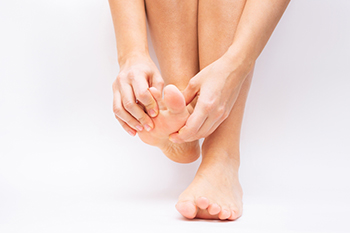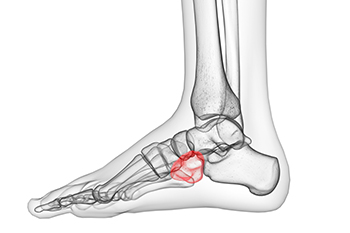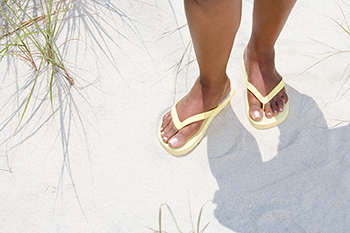(517) 487-5171
Fax (517) 908-0172
August 2022
How Does the Big Toe Function?

To many people, the toes might seem like small and insignificant parts of the human body. Nothing could be further from the truth. Although the toes are small, the function that they serve, not just for the feet but for the entire body, is monumental. The big toe, for instance, has an interesting biomechanical structure that benefits other parts of the body. Also known as the hallux, the big toe helps grip the ground to provide leverage during motion activities like walking and running. Additionally, the big toe helps the feet balance when an individual puts weight on their feet. Ultimately, the big toe is what helps keep an individual from falling anytime that they stand or engage in motion activities. Without the big toe, the foot would essentially have to relearn how to balance. This would force other parts of the foot to take on the balancing function that the big toe usually has. The big toe can be susceptible to a multitude of different afflictions and foot conditions, including gout, ingrown toenails, and sesamoiditis. It is therefore critical that one takes extra care of this body part to keep it from falling prey to any of these afflictions. If you want to learn more about the function of the big toe, contact a podiatrist.
If you have any concerns about your feet, contact Dr. Gary Cesar from Michigan Foot and Ankle Center. Our doctor can provide the care you need to keep you pain-free and on your feet.
Biomechanics in Podiatry
Podiatric biomechanics is a particular sector of specialty podiatry with licensed practitioners who are trained to diagnose and treat conditions affecting the foot, ankle and lower leg. Biomechanics deals with the forces that act against the body, causing an interference with the biological structures. It focuses on the movement of the ankle, the foot and the forces that interact with them.
A History of Biomechanics
- Biomechanics dates back to the BC era in Egypt where evidence of professional foot care has been recorded.
- In 1974, biomechanics gained a higher profile from the studies of Merton Root, who claimed that by changing or controlling the forces between the ankle and the foot, corrections or conditions could be implemented to gain strength and coordination in the area.
Modern technological improvements are based on past theories and therapeutic processes that provide a better understanding of podiatric concepts for biomechanics. Computers can provide accurate information about the forces and patterns of the feet and lower legs.
Understanding biomechanics of the feet can help improve and eliminate pain, stopping further stress to the foot.
If you have any questions please feel free to contact our offices located in Lansing and Mt. Pleasant, MI . We offer the newest diagnostic and treatment technologies for all your foot and ankle needs.
When Your Big Toe Joint Suddenly Becomes Painful

There are purine compounds that are naturally present in the body. Purines are also in certain foods, such as shellfish, red meat, beer, wine, and salt. When the body breaks down purines, uric acid is generated as a by-product. If the body cannot properly expel this uric acid, it can crystallize and collect in joints. This is known as gout—a form of arthritis. Gout can occur on any joint in the body, but it typically forms first on the joint of the big toe. Gout attacks, or flares, can occur suddenly, with intense symptoms such as extreme pain, redness, warmth, and swelling in the affected joint. Some believe that reducing your consumption of purine rich foods may help keep gout at bay. Gout is also believed to be hereditary. A podiatrist can diagnose gout by analyzing uric acid levels in your joint fluid and blood. Symptoms can be managed with anti-inflammatory medications and other treatments. If the gouty crystals on your joints are excessive, surgery may be an option to repair damage to your joints.
Gout is a painful condition that can be treated. If you are seeking treatment, contact Dr. Gary Cesar from Michigan Foot and Ankle Center. Our doctor will treat your foot and ankle needs.
What Is Gout?
Gout is a form of arthritis that is characterized by sudden, severe attacks of pain, redness, and tenderness in the joints. The condition usually affects the joint at the base of the big toe. A gout attack can occur at any random time, such as the middle of the night while you are asleep.
Symptoms
- Intense Joint Pain - Usually around the large joint of your big toe, and it most severe within the first four to twelve hours
- Lingering Discomfort - Joint discomfort may last from a few days to a few weeks
- Inflammation and Redness -Affected joints may become swollen, tender, warm and red
- Limited Range of Motion - May experience a decrease in joint mobility
Risk Factors
- Genetics - If family members have gout, you’re more likely to have it
- Medications - Diuretic medications can raise uric acid levels
- Gender/Age - Gout is more common in men until the age of 60. It is believed that estrogen protects women until that point
- Diet - Eating red meat and shellfish increases your risk
- Alcohol - Having more than two alcoholic drinks per day increases your risk
- Obesity - Obese people are at a higher risk for gout
Prior to visiting your podiatrist to receive treatment for gout, there are a few things you should do beforehand. If you have gout you should write down your symptoms--including when they started and how often you experience them, important medical information you may have, and any questions you may have. Writing down these three things will help your podiatrist in assessing your specific situation so that he or she may provide the best route of treatment for you.
If you have any questions, please feel free to contact our offices located in Lansing and Mt. Pleasant, MI . We offer the newest diagnostic and treatment technologies for all your foot care needs.
Changes to the Work Area May Help the Feet

Many people have professions that require standing for the majority of the day. This can produce a variety of foot conditions, including swollen feet and varicose veins, in addition to overall body aches. The feet carry the weight of the body, and it is beneficial to elevate them as often as possible during the work day. When people work on their feet, there are less body positions to choose from. These restrictions limit the freedom to move around. Stretching frequently is suggested, which may be beneficial in improving flexibility. Limited range of motion in the body can reduce the blood supply to the muscles, often resulting in fatigue and muscle pain. There may be positive changes that can be made in the work space. These can consist of adjusting the height of the work table and benches, which may help to improve posture. Relief may be found when there is ample room to move freely, and the position of the body is changed, thus improving blood supply to the muscles. If you have questions about how the feet are affected by standing all day, please confer with a podiatrist who can help you to manage your work area.
While working on the feet, it is important to take the proper care of them. For more information about working on your feet, contact Dr. Gary Cesar from Michigan Foot and Ankle Center. Our doctor will treat your foot and ankle needs.
Working on Your Feet
Standing on your feet for long periods of time can cause stress and pain in your feet. Your whole body may experience change in terms of posture, back pain, bunions, callouses and or plantar warts. There are ways to avoid these conditions with proper foot care, smart choices and correct posture.
Positive Changes
Negative heeled shoe – Choosing this shoe type places the heel slightly lower than the ball of the foot. These are great for overall foot health. Find shoes that fit you correctly.
Go barefoot – Our feet were not designed to be enclosed for all hours of the day. Try to periodically expose your feet to air.
Eliminate Pain
Foot Exercises – Performing simple exercises, incorporating yoga and doing stretches are beneficial. This will allow increased blood flow to the area and muscles of the foot.
Achilles tendon – Stretching the foot out flat on the floor will relax the calf muscles and tendon. These exercises can be performed almost anywhere. Make sure you add these exercises to your daily regimen.
With a little bit of this information and knowing more about foot health, you will notice changes. Foot stretches and proper footwear will help with pain and prevent further issues.
If you have any questions please feel free to contact our offices located in Lansing and Mt. Pleasant, MI . We offer the newest diagnostic and treatment technologies for all your foot and ankle needs.
When the Cube-shaped Bone in Your Foot Becomes Dislocated

On the outer side of the foot in front of the heel, lies the cuboid bone. This cube-shaped structure helps connect the foot to the ankle, provides the feet with stability, and helps dissipate the mechanical force it bears while walking and standing. The cuboid bone can become dislocated, which is known as cuboid syndrome, or cuboid subluxation. This can occur as a secondary injury of a sprained ankle, excessive strain on the area, or if the foot rolls inward repetitively. Flat feet and osteoporosis can also contribute to an occurrence of cuboid syndrome. Cuboid syndrome can cause pain, tenderness, redness and swelling on the outside of the foot, and it may be difficult to move the ankle. Maintaining a healthy body weight, stretching before any physical activity is undertaken, and wearing properly fitted shoes can all reduce the risk of cuboid syndrome occurring. Check with a podiatrist for additional preventative methods, or to have the condition properly diagnosed and treated.
Cuboid syndrome, also known as cuboid subluxation, occurs when the joints and ligaments near the cuboid bone in the foot become torn. If you have cuboid syndrome, consult with Dr. Gary Cesar from Michigan Foot and Ankle Center. Our doctor will assess your condition and provide you with quality foot and ankle treatment.
Cuboid syndrome is a common cause of lateral foot pain, which is pain on the outside of the foot. The condition may happen suddenly due to an ankle sprain, or it may develop slowly overtime from repetitive tension through the bone and surrounding structures.
Causes
The most common causes of cuboid syndrome include:
- Injury – The most common cause of this ailment is an ankle sprain.
- Repetitive Strain – Tension placed through the peroneus longus muscle from repetitive activities such as jumping and running may cause excessive traction on the bone causing it to sublux.
- Altered Foot Biomechanics – Most people suffering from cuboid subluxation have flat feet.
Symptoms
A common symptom of cuboid syndrome is pain along the outside of the foot which can be felt in the ankle and toes. This pain may create walking difficulties and may cause those with the condition to walk with a limp.
Diagnosis
Diagnosis of cuboid syndrome is often difficult, and it is often misdiagnosed. X-rays, MRIs and CT scans often fail to properly show the cuboid subluxation. Although there isn’t a specific test used to diagnose cuboid syndrome, your podiatrist will usually check if pain is felt while pressing firmly on the cuboid bone of your foot.
Treatment
Just as the range of causes varies widely, so do treatments. Some more common treatments are ice therapy, rest, exercise, taping, and orthotics.
If you have any questions, please feel free to contact our offices located in Lansing and Mt. Pleasant, MI . We offer the newest diagnostic and treatment technologies for all your foot care needs.
Reminder: When Was the Last Time...?
Flip Flops May Have Negative Effects on the Feet

Many people choose to wear flip flops in the warmer months because of the many styles to choose from and their simplicity to wear. However, wearing flip flops can be harmful to the feet. Some of the ways the feet can be negatively affected include having a different gait, or walking style, and the toes can cramp from trying to keep the shoe on the foot. Additionally, the skin on the heels can become dry and cracked from frequently wearing this backless shoe, and the ankles may start to point inward. They typically do not provide any type of arch support, and if these types of shoes must be worn, it is suggested that they be worn for short periods of time. They are appropriate to wear to the beach, but are frowned upon if worn all day. If you would like additional information about how wearing flip flops can affect the feet, please speak with a podiatrist who can address any concerns you may have.
Flip-flops are not always the best choice of footwear. If you have any concerns about your feet or ankles, contact Dr. Gary Cesar from Michigan Foot and Ankle Center. Our doctor will assist you with all of your foot and ankle needs.
Flip-Flops and Feet
When the weather starts warming up, people enjoy wearing flip-flops. Flip-flops are comfortable, stylish, and easy to slip on and off; they're perfect for any summer beach goer. However, these shoes can cause harm to the feet.
How Can Flip-Flops Affect Me Long-Term?
- Ankle problems
- Hip problems
- Lower back problems
- Pain in the balls of the feet
- Problems with foot arches
- Changes in the way you walk
Are There Injuries Associated with Flip-Flops?
Yes. Since flip-flops are relatively weak and do not provide the same amount of support as sneakers, people who wear flip-flops regularly are more susceptible to injuries. On top of that, the open nature of the shoe makes your feet more prone to other problems, such as cuts and even infections. Common injuries and ailments include:
- Sprained ankles
- Blisters
- Infections
- Cuts and Scrapes
I like Wearing Flip-Flops. Are There Safe Alternatives?
When buying flip-flops, try to find ones that have sturdy soles and that are made of high-quality materials that will support for your feet. These flip-flops will cost more but will also last longer as a result.
If you have any questions please feel free to contact our offices located in Lansing and Mt. Pleasant, MI . We offer the newest diagnostic and treatment technologies for all your foot and ankle needs.







